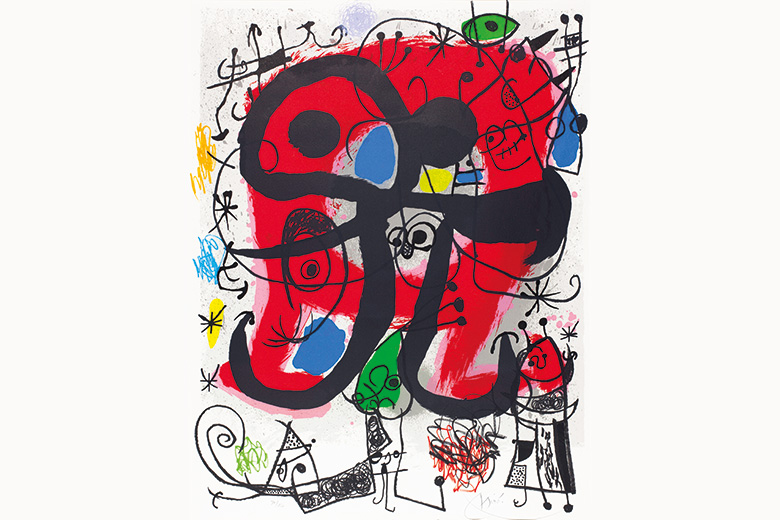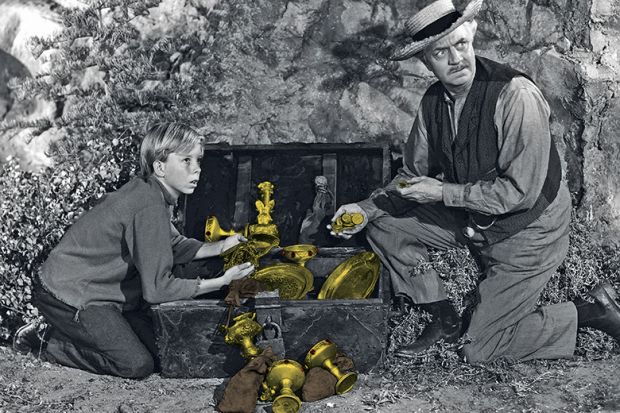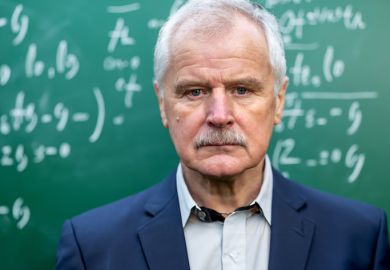Academics’ offices may be under threat at certain cost-conscious institutions, but those that remain often constitute scholarly Aladdin’s caves. Apart from books, they might include all manner of scholarly memorabilia and personal effects banned from the family home by unappreciative partners. Rumours also attest to the odd camp bed secreted behind mighty, yellowing walls of student essays dating back to 1980.
But which among these priceless treasures do their owners most value? Which would they grab first if the fire alarm went off and they were assured that, for once, it wasn’t a drill? Here, we ask 14 academics to describe the one object they would choose to save from the flames.
A link between past and present
After my laptop, I’d grab a tiny glass-topped box that slips easily into my pocket, and run. What it contains encapsulates my entire academic life. It is the bony beak-tip of a great auk from Funk Island, 40 miles off Newfoundland. Extinct since 1844, the great auk is the ultimate symbol of man’s greed and folly. It was the largest member of the auk family, and whose relatives, the puffin, razorbill and guillemot, I have studied since the 1970s. But its flightless vulnerability allowed it to be systematically exploited as a source of meat, fat and feathers.
When studying guillemots in Labrador in the 1980s, I sometimes climbed to a remote part of the island I was on and imagined discovering a tiny remnant population of great auks among the forbidding black basalt cliffs. What then? Keep it secret, or tell the world? Conservationists face such dilemmas all the time. In fact, I’d start a study: we know more about the deaths of great auks than we do about their lives. My bony fragment links the past with the present, keeps my fantasy alive and continues to fuel my biological curiosity.
Tim Birkhead is professor of behavioural ecology at the University of Sheffield. His most recent book is The Most Perfect Thing: the Inside (and Outside) of a Bird’s Egg (Bloomsbury, 2016).
A shrine to humour and eminent friends
I have rather cunningly clustered three items in one corner of my desk, so that they can be swept up together and carried out under one arm should I ever have to evacuate in haste. The first is my honorary degree from Discworld’s Unseen University, bestowed on me by my friend, the late Sir Terry Pratchett, back in 2008. It adds significant sparkle to my CV, and its very existence tickles me pink to this day.
Beside it resides a Gary Larson Far Side cartoon depicting a suspicious female chimpanzee plucking a blonde hair off her male companion’s back and accusing him of conducting research with “that Jane Goodall tramp”. It has always made me laugh. Dame Jane was kind enough to sign it for me when she received an honorary doctorate from the University of South Australia in 2014: turns out that it always made her laugh too.
The last item is an artwork produced by another late friend, South Australia graduate and honorary doctor, Sydney Ball. He sent it to me with an apologetic note pointing out that the Sistine Chapel had only taken marginally longer to paint. Syd’s Sistine, exploring the fascination he had with the relationship between colour and form, is a composition of seven miniature canvases.
Humour and brilliance in equal measure: a common thread that runs through my treasures, and definitely worth saving.
David Lloyd is vice-chancellor of the University of South Australia.
Affirmation of purpose
“There is a lot of rejection. It’s about purpose, process and people.” This is the advice that a trusted mentor gave me when I asked how he had survived 30 years of teaching and mentoring students, writing grant applications, publishing books and articles and serving in academic administration. I took it to mean that in order to stay in it for the long haul, I needed to focus on the value of academic work, to enjoy carrying it out and to make sure I have a positive impact on my students. So if there were a fire I would rescue two things. One is a book in which I keep encouraging notes that my students have written me over the years. The other is a notebook in which I write down the biggest research ideas that my students and I have thought up. Even if I could never implement them all myself, it is good to have something to pass on to students who are having trouble thinking of project ideas. I would let the rejection letters burn.
Elaine Howard Ecklund is Herbert S. Autrey chair in social sciences and professor of sociology at Rice University, where she is also founding director of the religion and public life programme.
Wheels of fortune
If a fire broke out I’d overlook my doctoral thesis, my 25-metre swimming certificate, my Lawrence and Wishart three-volume Das Kapital and my complete set of the Journal of Social Policy. You can always get new copies of such things, but my carbon fibre road bike is the first bike I’ve had that wasn’t second-hand. It would be a very unfitting end for such a magnificent machine (11-speed; Shimano 105 brakes and gears; ceramic bearings; profile spokes) to melt in the flames. Mind you, it wouldn’t be easy getting it down the fire escape.
Peter Taylor-Gooby is research professor of social policy at the University of Kent and author of The Baby Auction (2016) and Ardent Justice (2017).
Instrumental ink
I would exit clutching my black Caran d’Ache Léman fountain pen. Working on a computer brings many advantages, such as streamlining work and minimising the burden of record-keeping. Some colleagues even claim to think better using a keyboard. Not me: I enjoy the connection between nib and paper – particularly when developing ideas. The best days in my study are when I never switch a computer on at all.
I own several good pens. I’d grab the Caran d’Ache because I bought it with my partner and because it is elegant, good to hold, writes like velvet and doesn’t blot or block. Some pens are good for loose thoughts, others facilitate more disciplined thinking and some are comfortable for scrawling long drafts. The Caran d’Ache does all three well. At £420, it seemed an extravagant purchase, but it will almost certainly be writing 20 years hence. Whether I will still be the one holding it remains to be seen.
Helga Drummond is professor of decision sciences at the University of Liverpool Management School.
Doctoral memories
I would rescue my PhD thesis, which I wrote in the early 1980s. I suspect that I was one of the first generation of students to produce one on a computer – complete with a five and a quarter-inch data drive and a separate program drive. I don’t think I have the disks any more and I certainly couldn’t read them if I did. There is likely to be a copy of the thesis somewhere in the archives of the University of London; it might even be digitised. But that’s not my copy.
The experimental work (development of drug resistance in cancer, since you ask) is largely published, but the thesis is about more than the contribution to the discipline. It’s the memories: the stimulating research environment and supportive labmates; my wife typing up my references from dog-eared index cards until the early hours of the morning; the rainy walk from the binder’s to Senate House; the feeling that my thesis – which, unlike everything else, I somehow managed to keep dry – was going to change the world.
Having it around also reminds me how lucky I was to have a fully funded PhD in a dedicated research institute. And it prompts me to do what I can to ensure that such opportunities are not lost in the mad scramble for research funding, growing student debt and an anti-expert public mood.
Trevor McMillan is vice-chancellor of Keele University.

Miró image and a victory ball
I would try to carry to safety two items that are truly irreplaceable. The first is a lithograph created in 1971 by Joan Miró, which is part of Tufts University’s art collection. Like any work by a great artist, it is unique. And while it has hung in my office for some years, it has taken on additional resonance since last year, when an outstanding Boston art school with which we had a long association – the School of the Museum of Fine Arts – became part of Tufts, deepening our commitment to the arts.
The second is a football given to me for safekeeping by team members after a 2014 victory that ended a 31-game losing streak and marked the beginning of a turnaround for our football programme. More than 3,500 fans stormed the field that afternoon in a moment of solidarity and celebration that I will never forget.
An example of individual creativity and a reminder of team effort and campus spirit: the print and the football are daily reminders of what makes universities vital.
Anthony P. Monaco is president of Tufts University.
Outpouring of appreciation
We all know that students these days are digital natives, but that hasn’t killed a most heartwarming habit: leaving cards telling the story of what you and your teaching has meant to them. Sometimes, such as when a doctoral student has bagged a job, it may come with a bottle of champagne or a gift hamper, but they sparkle no less without such goodies. Should a fire invade my office, I would save these cards, culled from my teaching stints in three countries: Canada, the US and India.
If I was able to save only one, heartbreaking though the choice would be, I would opt for the one from a non-traditional student at least a decade older than me, who wrote: “Some time during your opening lecture I heard someone say in class: ‘I was dying to go to the restroom but I just couldn’t for fear of missing a word!’”
It’s not every day that one is accused of delivering a pee-stopping lecture.
Saikat Majumdar is professor of English and creative writing at Ashoka University.
Hazel’s ape
My partner, Carol, works in the office next to me – I’m sure she wouldn’t need saving, but I’d make sure she got out. Beyond that (her), I’d save Hazel’s statue.
Hazel was my grandmother – a quiet woman, and very proper. She and my grandfather owned a little pharmacy in central Pennsylvania. Each year, in the 1950s, they would travel to New York City to the “gift show”, a wholesale fair that sold various cards, gifts and knick-knacks. In 1959, there was a strange addition to the Hallmark-style cards and china figurines: a two foot statue, cast in bronze, of an ape sitting on a stack of books. These include On the Origin of Species and the Bible. A page from Genesis is showing, and on it is written “eritus sicut deus”—“and ye shall be as God”. The chimp is holding a human skull: Rodin’s Thinker contemplating his poor Yorick.
Titled “Affe mit Schadel” – Ape with Skull – the statue is a reproduction of a famous work that disappeared in the 19th century. My grandmother had to have it. But she didn’t say so: she just ordered it for the drugstore – as a gift to be sold – and put it on the highest shelf. There it stood for nearly 40 years, before finally finding its way on to her bedside table – where it became a permanent fixture of my early memories.
I love that little animal almost as much as I loved Hazel – so much. Carol thinks it is the creepiest thing ever made, so it stays in my office. But it wouldn’t be far behind her in the stampede for the fire escape.
John Kaag is professor of philosophy at the University of Massachusetts Lowell.
A digital legacy
I’d grab my computer CPU/hard drive and leave the rest of my personal effects to the potential ash pile. My choice of the CPU is sad but earnest. Virtually every academic thought I’ve had for the past 20 years is in digitised format. Thus, having no access to those thoughts, which are largely typed, saved and temporarily forgotten, I would be trying to function with only a fraction of my brain.
I imagine that, in 10 years, the digitisation and storage of my teachings will render the physical form of me less important than the 0s and 1s that represent my work. Teaching is increasingly more about facilitating students’ assimilation of knowledge, altering our job description from “professors” to “content experts”, who record lectures that are broadcast as electronic particles to “customers” instead of “students”. Thus, saving my CPU, over all else, should enable me to preserve my body of work and, ideally, my livelihood.
Jennifer Schnellmann is associate professor of pharmacology at the University of Arizona.
Seat of learning
It used to be the case in the UK that the test of a true academic was the speed with which they could snatch up their laptop when the fire alarm went off in the British Library. I’ve often “joked” with my husband that should our flat ever be set alight, I would snatch up my ancient MacBook first and nudge him awake second. But the cloud storage of recent years means we need no longer risk smoke inhalation in order to rescue the “life’s work” that we used to store on our laptops.
I tend not to be sentimental about my books, which are liberally scrawled on, coffee-stained and dog-eared. So, if the flames were flickering at my office window, the only object I might make efforts to save would be an armchair: badly upholstered, an ugly mint green, but inherited from a long line of exhausted academics who have slumped in its impossibly cosy depths for a mid-afternoon nap. Over the years, students have sobbed into its armrests, and colleagues have crumpled against its cushions. Once, a friend’s dog tried to wee against its leg. I’m thinking of thanking the chair in my acknowledgements.
Shahidha Bari is senior lecturer in Romanticism at Queen Mary University of London.
An irreplaceable drinking vessel
The shortlist comes down to four things, my viruses, my data, my students or my tea mug.
In the absence of a sufficiently cold freezer at home there’s not much I can do to save my viruses. So I think I will have to sacrifice those and trust my collaborators to provide.
My data are precious to me, but in theory they are backed up and the hard drive is stored safely (in a safe I liberated from a previous office).
My staff would be harder to replace, but it’s tricky to choose just one of them. There’s a couple whose contracts are running out, so they’re lower priority. I’d still need to choose from two – potentially the one who’s closest to publishing – pour encourager les autres as it were. Let’s assume they’re capable of leaving a burning building and move on.
So in the heat of the moment, I think that I would grab my tea mug: it’s got the structure of caffeine on it and although it could do with a wash, I’ve had it since my PhD. And it is, unlike the students, irreplaceable.
PS Of course this is all tongue-in-cheek – I would actually grab my wallet, head to Costa and watch the fireworks. (I am fond of that mug, though.)
John Tregoning is senior lecturer in the mucosal infection and immunity section of virology at Imperial College London.
Potent present
In the University of Natural Resources and the Environment in East New Britain, Papua New Guinea, you are more likely to be running to the exit because of an earthquake rather than fire. For that reason, there is not much in my office to grab. However, sitting proudly on the shelf is a bottle of Haig Club single grain whisky that definitely deserves saving.
This bottle was given to me as a bribe – sorry, I mean as a gift from a local construction company that was anxious to resume building work on our university library. The previous v-c is still being investigated by the national fraud squad because of missing millions related to this project. For this reason, the whisky remains untouched.
More significantly, the incident precipitated the formation of our University Ethics Committee, and the drafting of our policy on the acceptance of gifts. In Melanesian culture, such giving and receiving is very important. But these “gifts” usually arrive with associated obligations – or hangovers, as we call them in the West.
John Warren is vice-chancellor of the Papua New Guinea University of Natural Resources and Environment.
Testament to a life of teaching
I would open my desk and grab my pile of handwritten letters and notes that students have written me over the years. Some thank me for writing recommendations. Others comment on an influential class that helped determine a career path. Some thank me for moments or years of mentorship.
The letters remind me that the sum of higher education can be greater than its parts. It is not always easy to see the fruits of our efforts as academics steeped in our research, but advising students – developing good character, moulding leaders, inspiring civic engagement – is a true privilege.
Nancy W. Gleason is a senior lecturer in global affairs at Yale-NUS College in Singapore.
POSTSCRIPT:
Print headline: A roomful of riches
Register to continue
Why register?
- Registration is free and only takes a moment
- Once registered, you can read 3 articles a month
- Sign up for our newsletter
Subscribe
Or subscribe for unlimited access to:
- Unlimited access to news, views, insights & reviews
- Digital editions
- Digital access to THE’s university and college rankings analysis
Already registered or a current subscriber? Login




